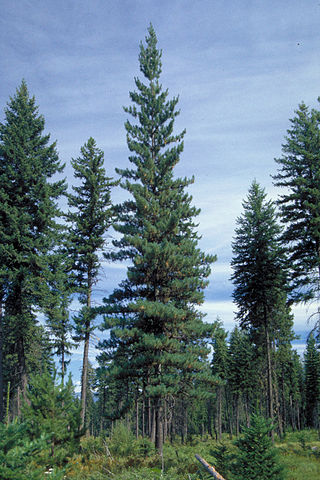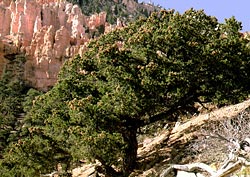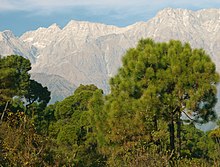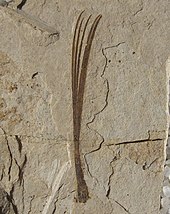
A pine is any conifer tree or shrub in the genus Pinus of the family Pinaceae. Pinus is the sole genus in the subfamily Pinoideae.

The pinyon or piñon pine group grows in southwestern North America, especially in New Mexico, Colorado, Arizona, and Utah. The trees yield edible nuts, which are a staple food of Native Americans, and widely eaten as a snack and as an ingredient in New Mexican cuisine. The name comes from the Spanish pino piñonero, a name used for both the American varieties and the stone pine common in Spain, which also produces edible nuts typical of Mediterranean cuisine. Harvesting techniques of the prehistoric American Indians are still used today to collect the pinyon seeds for personal use or for commercialization. The pinyon nut or seed is high in fats and calories. In the western United States, pinyon pines are often found in pinyon–juniper woodlands.

Pinus albicaulis, known by the common names whitebark pine, white bark pine, white pine, pitch pine, scrub pine, and creeping pine, is a conifer tree native to the mountains of the western United States and Canada, specifically subalpine areas of the Sierra Nevada, Cascade Range, Pacific Coast Ranges, and Rocky Mountains. It shares the common name "creeping pine" with several other plants.

Western white pine, also called silver pine and California mountain pine, is a species of pine in the family Pinaceae. It occurs in mountain ranges of northwestern North America and is the state tree of Idaho.

Pinus flexilis, the limber pine, is a species of pine tree-the family Pinaceae that occurs in the mountains of the Western United States, Mexico, and Canada. It is also called Rocky Mountain white pine.

Pinus strobiformis, commonly known as southwestern white pine, Mexican white pine or Chihuahua white pine, is a medium-sized white pine tree whose native habitat is in southwestern United States and Mexico. It is typically a high-elevation pine growing mixed with other conifers.

Pinus canariensis, the Canary Island pine, is a species of gymnosperm in the conifer family Pinaceae. It is a large, evergreen tree, native and endemic to the outer Canary Islands of the Atlantic Ocean.

Pinus virginiana, the Virginia pine, scrub pine, Jersey pine, possum pine, is a medium-sized tree, often found on poorer soils from Long Island in southern New York south through the Appalachian Mountains to western Tennessee and Alabama. The usual size range for this pine is 9–18 m, but can grow larger under optimum conditions. The trunk can be as large as 20 inches diameter. This tree prefers well-drained loam or clay, but will also grow on very poor, sandy soil, where it remains small and stunted. The typical life span is 65 to 90 years.

Pinus cembra, also known as Swiss pine, Swiss stone pine, Arolla pine, Austrian stone pine, or just stone pine, is a species of pine tree in the subgenus Strobus.

Pinus sibirica, or Siberian pine, in the family Pinaceae is a species of pine tree that occurs in Siberia from 58°E in the Ural Mountains east to 126°E in the Stanovoy Range in southern Sakha Republic, and from Igarka at 68°N in the lower Yenisei valley, south to 45°N in central Mongolia.

Pinus johannis, the Johann's pine, is a pine in the pinyon pine group, native to North America. The range extends from southeast Arizona and southwest New Mexico, United States, south in Mexico along the Sierra Madre Occidental and the Sierra Madre Oriental to southern Zacatecas and San Luis Potosí. It occurs at moderate to high altitudes, from 1,600–3,000 metres (5,200–9,800 ft), in cool, dry climate conditions.

Pinus culminicola, commonly known as Potosí pinyon or Potosí Piñón, is a pine in the pinyon pine group, native and endemic to northeast Mexico. The range is highly localised, confined to a small area of high summits in the northern Sierra Madre Oriental in Coahuila and Nuevo León, and only abundant on the highest peak, Cerro Potosí. It occurs at very high altitudes, from 3000–3700 m, in cool, moist subalpine climate conditions.

Pinus edulis, the Colorado pinyon, two-needle piñon, pinyon pine, or simply piñon, is a pine in the pinyon pine group native to the Southwestern United States, used for its edible pine nuts.

Pinus monophylla, the single-leaf pinyon, is a pine in the pinyon pine group, native to North America. The range is in southernmost Idaho, western Utah, Arizona, southwest New Mexico, Nevada, eastern and southern California and northern Baja California.

Pinus aristata, the Rocky Mountain bristlecone pine, is a long-living species of bristlecone pine tree native to the United States. It appears in the Rocky Mountains in Colorado and northern New Mexico, with isolated populations in the San Francisco Peaks in Arizona and the Kaibab National Forest north of the Grand Canyon. It is usually found at very high altitudes, from 7,000–13,000 feet (2,100–4,000 m), in cold, dry subalpine climate conditions, often at the tree line, although it also forms extensive closed-canopy stands at somewhat lower elevations.

Pinus maximartinezii, called Martinez pinyon, big-cone pinyon or maxipiñon, is a pine in the pinyon pine group, native to west-central Mexico.

Pinus dalatensis, also known as Vietnamese white pine or Dalat pine, is a species of pine endemic to Indochina. In Vietnam it grows in the mountains of the central and south-central parts of the country at elevations of 1,400 to 2,300 metres. Only recently confirmed from Laos, the population located within the Nakai-Nam Theun Biodiversity Conservation Area is the largest, at the lowest elevation, and the northernmost of the known populations of P. dalatensis.

Pinus nelsonii, Nelson's pinyon, is a species of pine native to the mountains of northeastern Mexico, in Nuevo León, San Luis Potosí and Tamaulipas at 1,800–3,200 m altitude.

In botany, a fascicle is a bundle of leaves or flowers growing crowded together; alternatively the term might refer to the vascular tissues that supply such an organ with nutrients. However, vascular tissues may occur in fascicles even when the organs they supply are not fascicled.
Pinus driftwoodensis is an extinct species of conifer in the pine family solely known from early Eocene sediments exposed in south central British Columbia. The species was described from an isolated fossil ovulate cone associated with a series of wood, needles and pollen cones in chert. P. driftwoodensis was the eighth pine species to be described from a permineralized ovulate cone and the second from the Okanagan highlands.



























